News from 2009. |
| In September 2009 we had a very well attended day with over 30 members and invited guests going round three herds on the North Yorkshire moors and coast. The day starts at 10am with a visit to the Drew’s Organic farm at Glaisdale where we viewed their small herd of Dexter’s and organic vegetable farm and learned about the benefits of farming Organically. The beef is sold at farmers markets along with their organic vegetables. Pauline and family had put on a lovely spread of home made biscuits and cakes. |
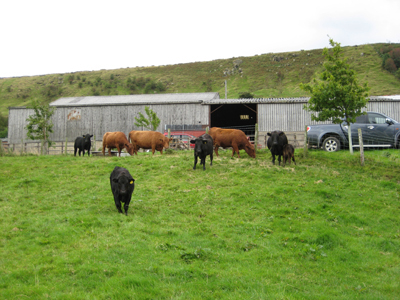 |
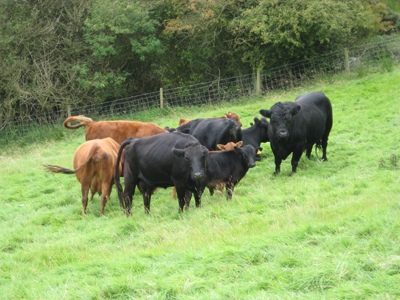 |
We left the Drew’s small holding at approx 12am to go onto our next visit, which was the Adams family at Raw where we viewed Janet and Alan’s herd of dexters and enjoy wonderful views of Whitby while we enjoy our lunch, Alan had made to big pots of wonderful homemade soup and the views from the garden of Whitby and the sea as we ate our lunch made everyone envious of the Adams holding. This holding is very sheltered and the cattle can remain out all year and beef is sold both online and at farmers markets. |
| Our last visit was again just along the coast at Pip & John Le Cornu farm just behind Flyingdales. Here we viewed their herd of Dexter’s, and show flock of Teaswater Sheep, plus old English pheasant fowl and Bourbon red turkeys. To finish our day there was a wonderful array of homemade cake and tea or coffee. |
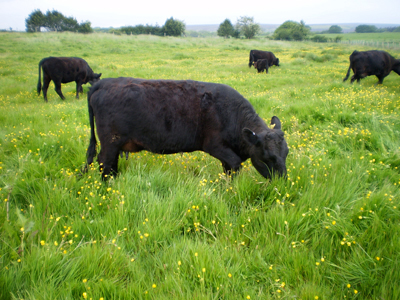 |
News from 2010. |
Calf Show Results June 2010 & Pictures |
The Groups Calf show was held on 6th June 2010 at Thirsk auction Mart.
We had a really good turn out of members with 19 animals entered so lots to watch for the non-showing members.
The venue was excellent with a secure ring and pens for the cattle and the building is clean and airy with secure bays for loading and off loading.
Our Judge for the day was Mrs Carol Clarke who explained her placing’s to everyone as she handed out the rosettes. |
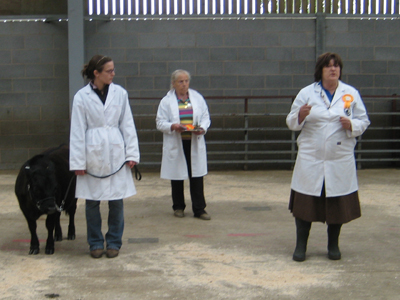 |
So helpful, as its always nice to know the judges reasons for placements both as an exhibitor or a spectator.
All the spectators had been given sheets so that they could place the animals themselves and then see how well they had judged the animals.
After the classes had been judged our judge and our chairlady took to the ring with some animals to explain the main points to look for when choosing cattle for showing. Many of these points are also relevant when choosing animals for breeding. We had an excellent display of raffle prizes so even if you didn’t win a rosette you had a chance of a nice raffle prize.
Overall, a very enjoyable day.
We did not have an official photographer however I gave my camera to a member who very kindly took the photo’s below. Thank you Pauline.
This year we had several youngsters showing calves. |
|
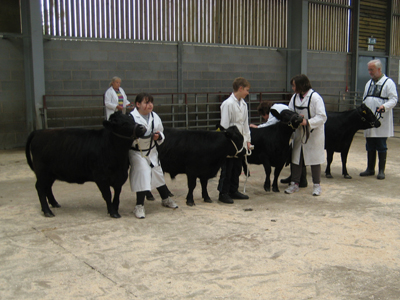 |
| Carolann brought two heifers, which she gave to two of our members for the day to show and I’m not sure if Caroline will be showing again as her little dexter was being rather naughty, but I’m sure we might see Richard in the ring next year with one of their calves. |
|
The results for the classes are as follows
Class I Under 6mths
1st Nuttall’s Jordeth Honey
2nd Myhill’s Steer calf
3rd Nuttall’s Jordeth Ireen
4th Nuttall’s Jordeth Joe
5th Sykes Steer calf
6th Nuttall’s Jordeth Mandy |
|
Class 2 Under 12mths
1st Gates Bull calf
2nd Ryders Topster St Catherine
3rd Littler’s Bluebell
4th Gates Eagleridge Ginger Maddie
5th Knott’s Bracken |
|
Class 3 Under 18mths
1st Ryder’s Topster Little Dot
2nd Sykes Hill Grove Janine
3rd Myhill’s Humberdale Violet
4th Nuttal’s Steer
5th Sykes Hill Grove Jemmima |
|
|
The Champions where taken from the above classes. |
|
|
| Champion was Gates Bull calf handled though out by Brendan Drew. |
Reserve champion was Ryder’s Topster Little Dot. |
Cow class
1st Sykes Hill Grove Jemma
2nd Myhill’s Humberdale Tulip
3rd Ryder’s Cow |
|
Yorkshire Show Results July 2010. |
| COW CLASS |
Ist Hill Grove Jemma (Miss S Sykes)
2ND Knightsway Jollity (Mr Cambridge)
3RD Toadhole Sherry (Miss S Sykes) |
HEIFER OVER 2 UNDER 4 YRS OLD
1ST Plane Tree Iris (Mrs K Darnbrook)
2nd Plane Tree Penelope (Mrs K Darnbrook)
3rd Washingpool Windflower (Mr Cambridge)
4th Honeycombe Diamond (Mr Cambridge) |
|
HEIFER OVER 1 UNDER 2 YRS OLD
1ST Plane Tree Galatea (Mrs K Darnbrook)
2ND Buryhill Anna Lucia (Miss Z Cambridge)
3rd Hill Grove Janine (Miss S Sykes)
4th Toadhole Candy (Miss S Sykes) |
|
CALF UNDER 1 YR OLD
1st Cadwgan Rhubarb (Miss Z Cambridge)
2nd Plane Tree Eros (Mrs K Darnbrook)
3rd Buryhill Amelia (Miss Z Cambridge) |
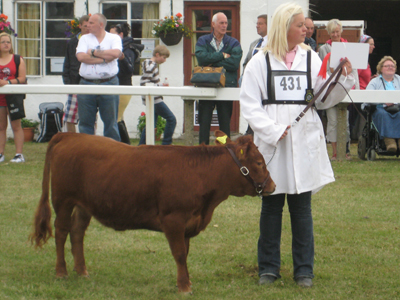 |
BULL OVER 1 YR OLD
1st Saltaire Pigment (Miss Z Cambridge)
2nd Plane Tree Talos (Mrs K Darnbrook)
3rd Buryhill Rory (Miss Z Cambridge) |
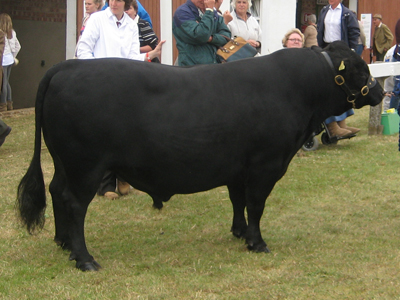 |
| JUNIOR CHAMPION PLANE TREE GALATEA |
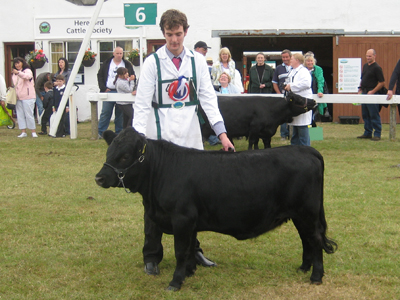 |
| RESERVE BURYHILL RORY |
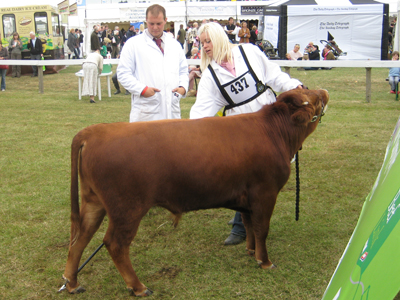 |
CHAMPION PLANE TREE IRIS
RESERVE SALTAIRE PIGMENT
|
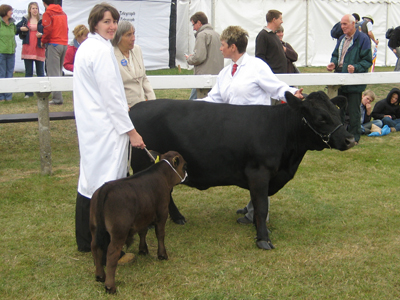 |
GROUP OF 3 ANIMALS
1st Miss S Sykes
2nd Mrs K Darnbrook
3rd Miss Z Cambridge |
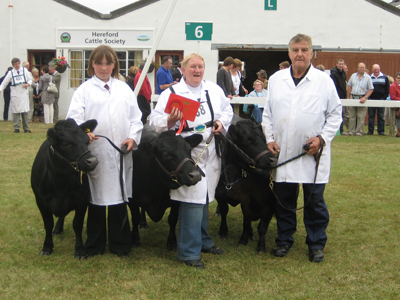 |
| Pairs Class |
1st Mrs K Darnbrooks
2nd Miss S Sykes |
| Visit to Langthorne Buffalo Farm. Aug 2010 |
On 22 August a group of about 20 of us from the Northern Dexter Group visited the Langthorne Buffalo Farm near Northallerton. It was a glorious sunny day and I for one was beginning to regret that I had forgotten my sunglasses and hat. Hard to imagine that now we are in the middle of a grey autumn in North Yorkshire! I needn’t have worried as the trailer for the tour was benched and covered so we were going to travel in some style compared to the open cart and straw bales I was expecting.
Once we were all loaded on the trailer our first stop was a paddock occupied by Pere David deer, emus and guanacos. The latter are ancestors to the domestic llama. |
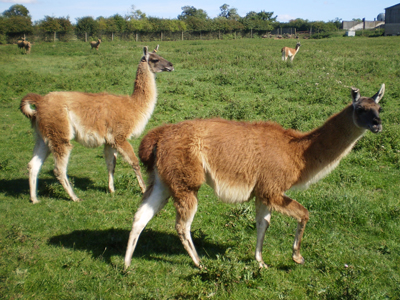 |
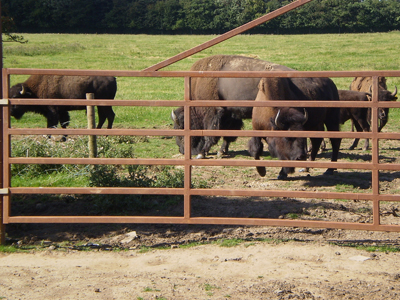 |
The highlight though was at the gate at the other side of the paddock. The sturdy gate was framed by a tall metal stanchion reminiscent of Jurassic park. Through the gate we could see several magnificent bison.
Once we were off again we turned a corner in the field to be faced with a seemingly enormous herd of buffalo! They were very calm with a similar temperament to Dexters. It was fascinating to see them close up and to also spy the odd Dexter amongst them. There were several wallows around which interestingly the buffalos had created themselves where feed had been put down. |
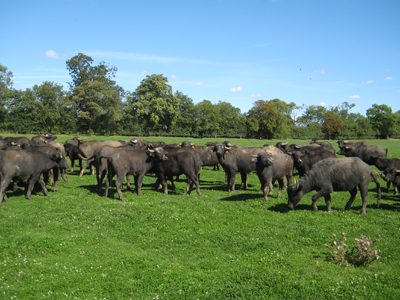 |
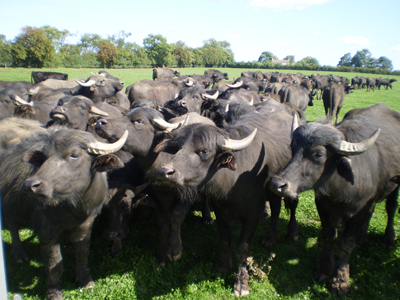 |
| The next gateway (and one or two after that!) produced more adventure when the trailer got stuck in the enormous ruts caused by last winter. The girls did a magnificent job in pulling the 4x4 plus trailer through. Nobody had to get off although a few of us took the photo opportunity. |
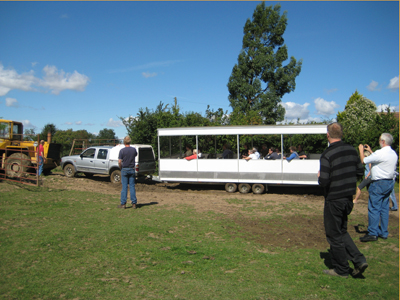 |
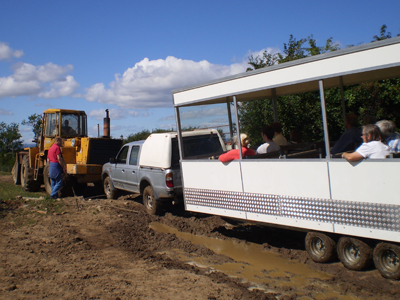 |
The new field housed a very large herd of red deer. These were naturally shy but some came up to the feed thrown out of the back of the trailer. Paul explained that, to reduce stress, rather than herd them to the slaughter house he shot them individually at feeding time in the presence of a vet. The other deer seemed unperturbed by this and would carry on feeding regardless!
The next large herd was an equally fascinating group of wapiti, or elk, an American deer species. Paul keeps these as they have a slightly less strong or gamey flavour than the red deer. Some of these would come up and be fed by hand. |
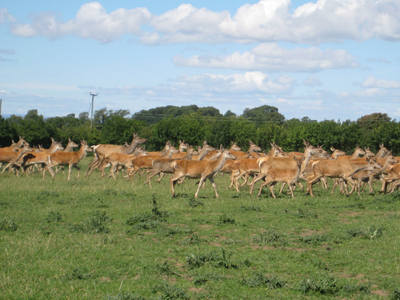 |
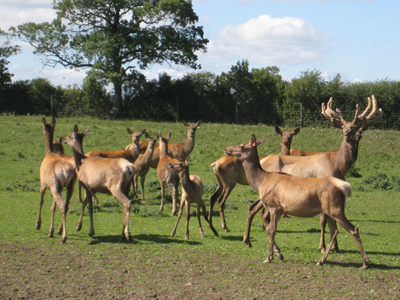 |
| We then went through a very large area of pasture occupied by numerous different breeds of cattle and their crosses. There were Highlands, White Park, Dexters and ……Yaksters. A Yakster is a cross between a Yak and a Dexter! They are distinguished by their colour and a very fluffy tail! |
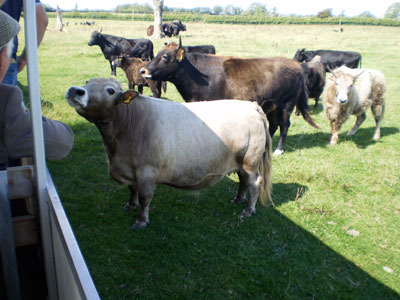 |
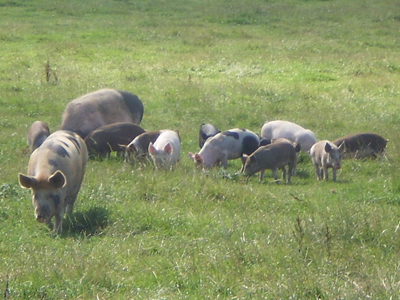 |
Finally we passed a flock of soay sheep and then went through a last field before completing a full circle. This last field housed Yaks and Dexters and a wonderful herd of miscellaneous and iron age pigs. These roamed free with their piglets with very little evidence of rooting due to the large area.
Once back at the farmhouse we were treated to really meaty buffalo burgers or iron age pork sausages before a tour of the abbatoir. This was very interesting and in a way quite reassuring. Paul said that he would slaughter and butcher an average Dexter steer for £275. Slaughter days are Tuesdays. For further information, contact Langthorne Buffalo Farm on 01609 776937
Pip Le Cornu
(A full version of the visit will be in the Autumn newsletter.) |
| Visit to the Welland Herd. |
In September our Chairman, Carolann Raybould, kindly invited us all to visit her Welland Herd at Stallingborough near Grimsby. On a cold and very windy day around 30 members arrived to be greeted by Carolann and her husband Andrew with a huge spread of cakes, biscuits and a very welcome cup of tea in the shelter of a marquee.
We started by looking at a group of steers of different ages, a couple of which were nearly ready for slaughter. It was very useful to see a range of steers at different stages. |
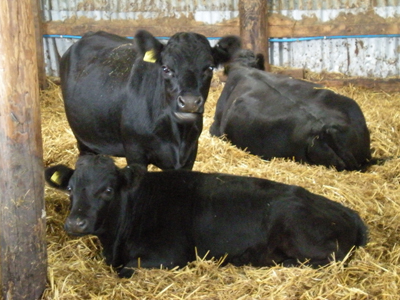 |
| We then moved on to look at Carolann’s short herd, which Carolann is in the process of rebuilding after she lost all her stock during Foot & Mouth. They were a real credit to Carolann’s commitment to the Dexter breed. |
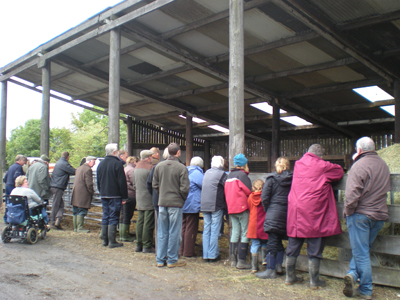 |
| In another shed we looked at the non-short herd. There was more of a range of types in this group and Carolann told us that it can take a long time to breed up the kind of stock that you want. Carolann explained that you can’t just put a good bull to a bad cow, or vice versa, and expect to get a good calf – both the sire and dam need to be of good quality. Ideally if you were looking to buy a cow you should try to look at as much of the family group and her offspring as possible, to get an idea of the quality of future calves. |
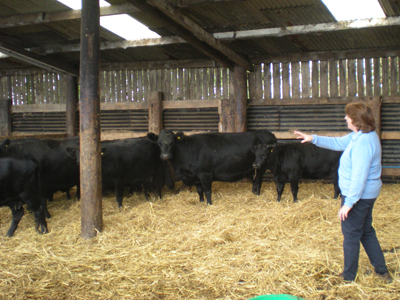 |
| We then returned to the marquee for a delicious lunch, including more tea and cake, and an opportunity to catch up on other members’ news. |
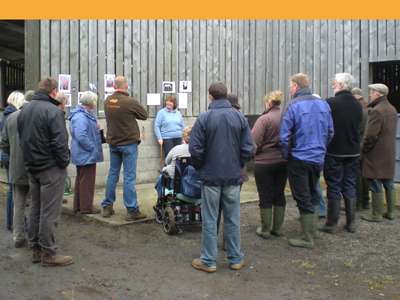 |
After lunch we had a very informative discussion on ‘Milk Makes Meat’ and on ‘What to Look for in a Good Bull’, with live examples. In the first session, with one of Carolann’s lovely short cows as the model, we learnt about the importance of a good udder with illustrations of the following points:
• Rear udder height: a high rear udder attachment is thought to be an indicator of more udder capacity
• Rear udder width: also an indicator of udder capacity
• Udder depth: this is the most important physical trait of the udder – higher udder are related with less mastitis, less udder injury, and greater longevity
• Udder cleft: a deep cleft is an indicator or a strong suspensory ligament, which provides 60% of the udder’s support
• Teat placement: this is the second most important physical trait of the udder – teats should be centrally placed on each quarter
• Fore udder attachment: this is the third most important physical trait of the udder and a good strong fore attachment indicates greater longevity
We learnt that a good udder is important, not just for showing purposes, but is also extremely important for Dexter beef producers because a good udder producing a good amount of milk gives the calf the best start in life and produces the fantastic meat that Dexters are renowned for. |
|
The next model to be brought out was Carolann’s non-short bull. We learnt that in order for cows to breed on a regular yearly cycle, the bull needs to be in top shape and condition. Using the live model, who was very accommodating, Carolann took us through the following vital points:
• Legs and feet
It is important that he has good legs and feet as before he performs his duty he has to constantly be able to keep up with the cows and check to see if they are ready to mate. It is very important that his legs and feet are correct as they will take all the weight when serving the cow. If the legs are too straight (‘posty’) it makes him predisposed to stifle problems, if they are bent too far underneath (‘sickle hocks’) it makes him predisposed to slipping.
• Back and loins
Must be strong to enable him to stay on top of the cow when serving
• Testicles and teats
Testicles must be a good size – small testicles produce less sperm – and both the same size – uneven testicles could mean deformed sperm. Teats must be of equal size and evenly spaced as this will affect the teats of his offspring.
• Changes in fertility
It is important to watch for changes as the bull gets older as these could mean fertility problems, including:
• Hair on head and neck growing longer and getting softer, and also hair sticking up on the poll
• Hair growing on testicles
• Spine sticking up proud of hips
Everybody we spoke to felt the day had been very worthwhile – it was an excellent combination of a social gathering and a great learning experience by combining the herd visit with the discussions afterwards. We would like to thank Carolann and Andrew Raybould very much for their kind hospitality, for sharing their knowledge, and for keeping us very well fed!
Caroline Littler and Richard Knott
Ferryboat Dexters
Thorganby, near York |
|